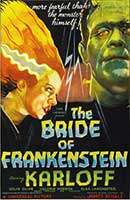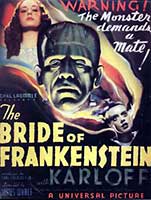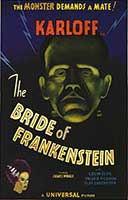Boris Karloff
Colin Clive
Valerie Hobson
Ernest Thesiger
Elsa Lanchester
Gavin Gordon
Douglas Walton
Una O'Connor
E.E. Clive
Lucien Prival
O.P. Heggie
Dwight Frye
Reginald Barlow
Mary Gordon
Anne Darling
The Monster
Henry Frankenstein
Elizabeth
Doctor Pretorius
Mary Shelley/The Monster's Bride
Lord Byron
Percy Bysshe Shelley
Minnie
Burgomaster
Butler
Hermit
Karl
Hans
Hans' Wife
Shepherdess



 The Bride of Frankenstein comes five years after the original Frankenstein. The film is funnier yet also more terrifying than the first film. The movie has an unorthodox setup. On a stormy night, Mary Shelley, Percy Shelley and Lord Byron are having after dinner brandies and discussing the yet-to-be published novel by Mary Shelley. Lord Byron is dramatically retelling the tale of Dr. Frankenstein and his mad obsession to create a man out of lifeless flesh. The film cross-cuts to scenes from the original film to familiarize the audience with the story thus far. In a surprise twist on the novel, Mary Shelley informs the two that the story has not ended. There are much more macabre events to come.
The Bride of Frankenstein comes five years after the original Frankenstein. The film is funnier yet also more terrifying than the first film. The movie has an unorthodox setup. On a stormy night, Mary Shelley, Percy Shelley and Lord Byron are having after dinner brandies and discussing the yet-to-be published novel by Mary Shelley. Lord Byron is dramatically retelling the tale of Dr. Frankenstein and his mad obsession to create a man out of lifeless flesh. The film cross-cuts to scenes from the original film to familiarize the audience with the story thus far. In a surprise twist on the novel, Mary Shelley informs the two that the story has not ended. There are much more macabre events to come.
The real events of the film begin only moments after the ending of Frankenstein. The windmill is still on fire with the creature supposedly burned alive inside the raging inferno. Dr. Henry Frankenstein lies mortally wounded, moments from death after being thrown from the windmill by the creature. The villagers are celebrating the demise of “the monster”, aka Frankenstein's creation.
Henry Frankenstein (Colin Clive) is taken back to his castle where the townsfolk realize he isn't dead, yet. The grief-stricken father of the young child Maria, who was murdered in the first film, is obsessed with seeing the dead corpse of the monster. He climbs down into the wreckage only to discover that the creature has been burned but not destroyed.
The first bit of comic relief comes next. Servant in the Frankenstein household, Minnie (Una O'Connor) searches for her friend and finds the monster instead. She hysterically screams and wails while the monster (Karloff) looks at her with a “What the...” expression on his face. The monster is loose again but no one believes the wild tale of the very odd woman.
Henry is mending from his injuries. He and Elizabeth (Valerie Hobson) are back on track preparing for their delayed wedding. Henry's life is turned upside down when a creepy Dr. Pretorious (Ernest Thesiger) enters the castle late one night. Pretorious is a smooth talker yet still has a fingernails-on-chalkboard persona. This is a wonderful performance from Thesiger. Pretorious cannot be trusted under any conditions. To Henry's dismay and unquenchable curiosity, he listens to Pretorious' story.
 Pretorious has also been experimenting with creating life. He has been able to grow life in test tubes in his laboratory. He has been very successful but on a very small scale. He has created a king, queen, bishop, prince and a ballerina who only dances to one particular piece of music. This idiosyncrasy of the ballerina drives Pretorious crazy.
Pretorious has also been experimenting with creating life. He has been able to grow life in test tubes in his laboratory. He has been very successful but on a very small scale. He has created a king, queen, bishop, prince and a ballerina who only dances to one particular piece of music. This idiosyncrasy of the ballerina drives Pretorious crazy.
Frankenstein is amazed and intrigued but Pretorious' results. Yet, Henry refuses to continue with his own experiments. He knows the tragedy awaiting him if he continues. Pretorious is respectful of Frankenstein's wishes, but he continues working on a plan to force Henry to help him.
Meanwhile, the creature is undergoing his own growing pains. Boris Karloff is even better portraying the monster. Karloff brings a wider emotional range to the creature, calm and friendly one moment, a blind-raging monster the next. Karloff's hand gestures are an integral part to his portrayal of the creature. His hands are his only form of communication.
But something unforeseen and wonderful is happening to the creature. He is adapting and learning. While drinking from a water hole, he looks into the water and sees his reflection. He recognizes what he is looking at. For the first time in his short life, the creature sees the horrible features of his own face. The creature is enraged, slapping angrily at the reflection. He learns to become self-sufficient. He lives off of the land and avoids crossing paths with the local villagers, farmers and sheep herders.
The creature learns that no man is an island. He cannot run away from his problems forever. In a sequence eerily reminiscent from the original film, he crosses paths with a young shepherdess (Anne Darling). His first reaction is to try to be friendly. Her first reaction is pure terror. She falls into the waterhole and begins drowning. But now, the creature knows what to do. He jumps into the pond and saves the drowning girl. Is the creature's reward a thank you and a kiss on the cheek? No he is rewarded with more terrifying screams. Two hunters come to the shepherdess' aid and find the creature. Once again, Karloff is waving his arms as a sign of friendship. His kindness is repaid with a bullet in the arm. The creature is learning and remembering his interactions with “normal” people.
 In his wildest imaginings, the creature cannot comprehend what is about to befall him. He knows pain from being burned and shot. He knows fear, anger, rage, terror. A simple piece of music played on a violin calms the savage heart. A blind hermit is alone in his cabin partaking of a little music to end the night. The creature is calmed and intrigued by this event. He does not, however, know how to take the next step. So, he barges into the cabin growling.
In his wildest imaginings, the creature cannot comprehend what is about to befall him. He knows pain from being burned and shot. He knows fear, anger, rage, terror. A simple piece of music played on a violin calms the savage heart. A blind hermit is alone in his cabin partaking of a little music to end the night. The creature is calmed and intrigued by this event. He does not, however, know how to take the next step. So, he barges into the cabin growling.
The creature does not get what he expected. The hermit welcomes the creature into his home. An interesting question is whether the hermit would invite the creature into his cabin if he were not blind? For the first time in his short life, the creature experiences peace, tranquility, happiness and friendship. The hermit begins teaching his new friend how to speak. The creature now learns the ability to express himself. He isn't perfect but what he doesn't know how to say, he can convey what he wants by merely picking up the hermit's violin.
The creature also learns two valuable lessons: Good and Bad... and good things can be used to do bad things. Fire was a source of pain and torment. But fire can be used for cooking, lighting candles or lighting the end of a cigar. The creature lights his cigar and promptly overdoes his inhaling. Even in a black and white film, it does not take much imagination to see the creature's face turn green. Quite hilarious thanks to Karloff's acting prowess.
Ah, but no man is an island and every port of refuge has it's price. Two hunters (One being an uncredited young John Carradine) come upon the hermit's cabin. Seeing the monster, the hunters believe the hermit to be in grave danger. They mistakenly save him from the creature who has no intention of harming his friend. Another lesson: not all good intentions have good consequences. The hunters take the hermit away while the creature is helpless to aid his friend. The creature thinks these men will harm his friend and rage takes over. The cabin is burned to the ground and the creature is again alone.
 The creature has learned friendship. He has not learned that friendship is often misleading. People pretend to be friends as a tool to get you to do their bidding. This deception leads to the final tragic events of the film. The creature meets Dr. Pretorious. In the name of friendship, Pretorious uses the creature's innocence and naivete against him. The creature and Pretorious form an alliance to force Dr. Frankenstein to create a mate/friend for the creature.
The creature has learned friendship. He has not learned that friendship is often misleading. People pretend to be friends as a tool to get you to do their bidding. This deception leads to the final tragic events of the film. The creature meets Dr. Pretorious. In the name of friendship, Pretorious uses the creature's innocence and naivete against him. The creature and Pretorious form an alliance to force Dr. Frankenstein to create a mate/friend for the creature.
Pretorious has been busy with his own experiments. He has been creating a woman. His only problem is finding a heart that will sustain life. For this he needs Frankenstein's expertise. The two accomplish this by kidnapping Henry's bride Elizabeth. Henry has no choice but to help Pretorious. Once more, a creature is given life without considering the consequences. Everyone assumes that this new creation will be happy being paired with the creature. Reality always has a way of showing people the error of their ways. There is only one outcome: Disaster.
After being rejected, the creature learns his true nature. Similar to his bride, the creature realizes he was created from dead flesh. He allows Henry and Elizabeth to escape saying, “We stay dead. You live!” His final act is one of compassion and self-sacrifice. He destroys himself, the female creature and Pretorious, who lied to him, in a massive explosion that will reduce them to atoms.
 Director James Whale triumphs with this second tale because he expands on the multi-leveled emotional growth of the creature. The audience can relate to this outcast. The creature's only true fault is not being understood. People only see him based on his appearance. He looks like a monster so he is a monster. Plain and simple. But everyone knows that looks can be deceiving. At least, this is something God hopes we humans understand. Reality has a way of teaching this lesson by harsh and sometimes tragic means. Thanks to the set pieces, cinematography and lighting, James Whale has crafted a timeless classic that no amount of color or special effects will surpass this film.
Director James Whale triumphs with this second tale because he expands on the multi-leveled emotional growth of the creature. The audience can relate to this outcast. The creature's only true fault is not being understood. People only see him based on his appearance. He looks like a monster so he is a monster. Plain and simple. But everyone knows that looks can be deceiving. At least, this is something God hopes we humans understand. Reality has a way of teaching this lesson by harsh and sometimes tragic means. Thanks to the set pieces, cinematography and lighting, James Whale has crafted a timeless classic that no amount of color or special effects will surpass this film.
One final note: since everyone knows that the name Frankenstein refers to Dr. Henry Frankenstein, not his creation. The creature is never given a proper name. So why is the film titled The Bride of Frankenstein? In the original script for this film, when Pretorious needs a heart to place in his female creation, his henchman Fritz was supposed to kill Elizabeth without Henry knowing. When Dr. Pretorious announces the arrival of the female creature as “The Bride of Frankenstein”, he means it quite literally. This was deemed too shocking for the audience and the script was rewritten. This is too shocking for modern audiences as well.
Movie review © Larry Novotny/Spectre Films Ltd. All Rights Reserved.
All images © 1935 Universal Pictures